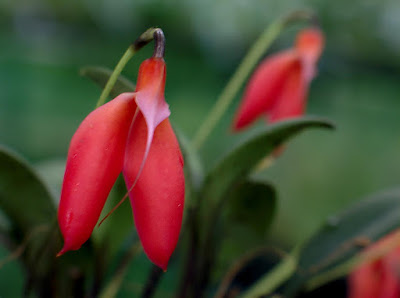Masdevallia deformis is native to Ecuador. This epiphytic species is found on the eastern slopes of the Andes in the south-eastern provinces of Zamora-Chinchipe and Loja. These plants were found at an altitude of 2400-2700 m...
Masdevallia deformis also called as The Misshapen Masdevallia, Masdevallia deformis f. exaltata, Masdevallia exaltata, is a species of the genus Masdevallia. This species was described by Friedrich Fritz Wilhelm Ludwig Kraenzlin in 1921. This species epithet is derived from the Latin for deformed, which refers to the proportions of the flower to the plant - an unfortunate epithet since this very beautiful species deserves a more charming name.
IDENTIFY MASDEVALLIA DEFORMIS
Masdevallia deformis is native to Ecuador. This epiphytic species is found on the eastern slopes of the Andes in the south-eastern provinces of Zamora-Chinchipe and Loja. These plants were found at an altitude of 2400-2700 m in the rain forest between Loja and Zamora and in the vicinity of Yangana, southeast of Loja. It was first discovered by the collector Hübsch in the mountains east of Loja, Ecuador, in the early part of the 20th century and described from dry herbarium material by Kränzlin in 1921. Although the species was originally thought to be quite rare, it was found in abundance along a new road south of Yangana, Ecuador, in 1982. (Unfortunately, most of these plants have disappeared from the regions near the highway due to extensive collection.)
It is a cool to cold growing, mini-miniature sized epiphyte, which reaching 5.5-14.5 cm in height, with blackish, erect, slender, 1.5-4.5 cm long ramicauls enveloped basally by 2 to 3 loose, tubular sheaths and carrying a single, erect, coriaceous, dark green, petiolate, elliptical, subacute to obtuse, 4-10 cm long leaf.
The Misshapen Masdevallia is cuneate below into the blackish petiole and a horizontal to ascending, 4 to 10 cm long, solitary flowered inflorescence occurring in the fall, winter, spring and summer. The flowers are 2 cm in diameter. The oblong dorsal sepal is connate to the lateral sepals, forming a cylindric sepaline tube, and the acute apex of the triangular free portion contracts into a slender, downward-directed tail. The lateral sepals form a broadly expanded synsepal beyond the sepaline tube, with rounded apices, abruptly contracting into short, slender tails. The lip is red to orange and can be both smooth and have short hairs.
MASDEVALLIA DEFORMIS CARE AND CULTURE
Cultural information should only be used as a guide, and should be to be adapted to suit you. Your physical location; where you grow your plants, how much time you have to devote to their care, and many other factors, will need to be taken into account. Only then can you decide on the cultural methods that best suit you and your plants.
Light:
Masdevallia deformis needs a light level of 8000-15000 lux. The light should be filtered and dispersed, and the plants should never be exposed to direct sunlight. Strong air movement should be ensured all the time.
Temperature:
The average summer temperatures are 21-22 ° C and the average temperatures are 9-11 ° C, with a daily amplitude of 11-12 ° C. In winter the average day temperature is 18-19 ° C, night 8 ° C, with a daily amplitude of 10-11 ° C.
Humidity:
The Misshapen Masdevallia needs the humidity of almost 75% throughout the year.
Substrate, growing media and repotting:
Masdevallia deformis grow well attached to pieces of tree ferns or cork with high humidity and daily watering during the summer. During the dry and hot periods it may be necessary to water several times a day.
These plants are usually grow in pots with a substrate that quickly draining excess water, which, however, contains substances that retain a certain amount, such as chopped sphagnum moss or perlite. Wood charcoal is also often added to ensure the air permeability of the substrate and protection against acidification.
It is recommend repotting the plants every year.
Watering:
Precipitation is low to moderate throughout the year. The substrate of the cultivated plants should be moist and should never be completely dry.
Fertilizer:
If the plants grow in sphagnum moss, tree fern or Osmund fern roots, they should be fertilized every 3-4 weeks 1/4-1/2 of the recommended dose of orchid fertilizer during the period of strong growth. If grown in a bed of pine bark, fertilization can be applied every 1-2 weeks.
At the beginning of the year, when plants grow actively, instead of fertilizers with equal proportions NPK, you can use fertilizers with high nitrogen content then in late summer and autumn use high phosphorus fertilizers to stimulate plants to flower.
Rest period:
Watering in winter can be somewhat reduced, especially in the case of Masdevallia deformis grown in darker places, in the conditions of a short day typical of higher latitudes. However, do not allow them to completely dry out. Fertilization should be limited until spring, when stronger watering resumes.















COMMENTS